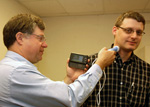Engineers create smartphones for ultrasound imaging

Proof that innovation is healthy in healthcare, two computer engineers have coupled USB-based ultrasound probe technology with a smartphone to create a compact mobile computational platform and a medical imaging device that fits into the palm of your hand.
Armed with a $100,000 grant from Microsoft last year, William D. Richard, Ph.D., Washington University Associate Professor of Computer Science and Engineering, and David Zar, Washington University Research Associate in Computer Science and Engineering, have created the first commercial USB ultrasound probes, which are compatible with Microsoft Windows Mobile-based smartphones.
According to an article from WUSTL, the researchers had to optimize every aspect of probe design and operation, from power consumption and data transfer rate to image formation algorithms. The result is a hand held device that can image the kidney, liver, bladder, and eyes, endocavity probes for prostate and uterine screenings and biopsies, and vascular probes for imaging veins and arteries for starting IVs and central lines. It can potentially help caregivers of patients with Duchene's Muscular Dystrophy, and find applicications in the military as well.
The ultrasound smartphone is not intended for the consumer market, so don't expect to be running your own scans between calls any time soon. The idea, say the researchers, is that the portable medical device could become the essential computer of the Developing World, where trained medical personnel are scarce, but most of the population has access to a cell phone tower.
Richard and Zar discussed a collaboration with researchers at the Massachusetts Institute of Technology about integrating their probe-smartphone concept into a suite of field trials for medical applications in developing countries. "We're at the point of wanting to leverage what we've done with this technology and find as many applications as possible," Richard said.
"Twenty-first century medicine is defined by medical imaging," said Zar. "Yet 70 percent of the world's population has no access to medical imaging. It's hard to take an MRI or CT scanner to a rural community without power."
Commercial ultrasound machines can run into the hundreds of thousands of dollars, and even portable "laptop" versions cost from a few thousand dollars up to $30K. The price tag for some of the USB-based probes is $2,000, but the goals is to bring it down to around $500.
The team demonstrated the technology at the Microsoft Research Techfest 2009 in February.
